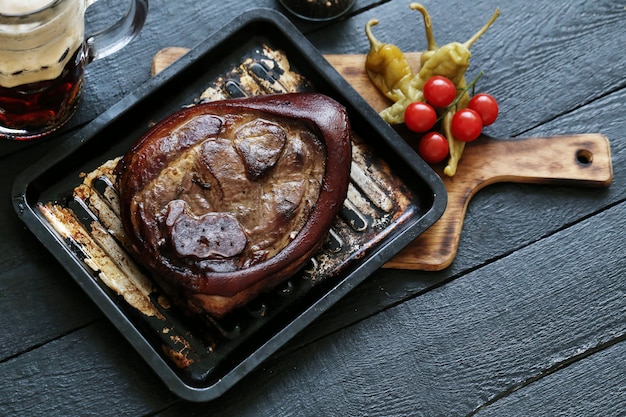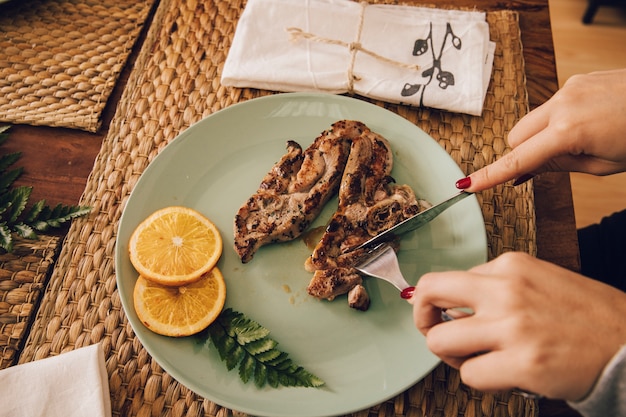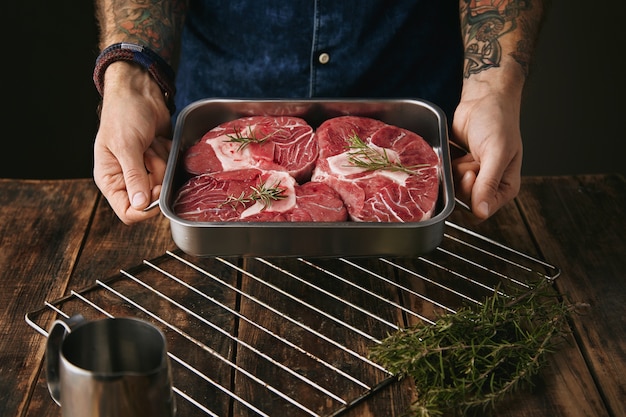(Part 1) Choosing the perfect beef tenderloin

What to Look For
- Marbling: Think of it like the swirls in a beautiful piece of marble. Look for a cut with good marbling, meaning it has streaks of fat running through the lean meat. The more marbling, the more flavorful and juicy the steak will be.
- Color: A bright, deep red color is a good sign. This indicates that the meat is fresh and hasn't been sitting around for too long.
- Texture: The meat should feel firm and springy to the touch, not mushy. This is a sign of quality and good handling.
Size and Shape
For a smaller gathering, a 1-1.5 kg tenderloin is perfect. For a larger group, you can go for a 2-3 kg piece. If you're not sure, it's always better to err on the side of too much rather than too little. You can always freeze any leftovers for another day!
Cutting and Trimming
If you're buying a whole tenderloin, you'll need to cut it into individual steaks. I usually aim for steaks that are about 2-3 cm thick. This thickness ensures a nice sear and a juicy interior. You want a good crust on the outside and a perfectly cooked center. Once you've cut your steaks, you can trim any excess fat or silver skin. Don't worry, you can always save the trimmings for making a delicious stock later!
(Part 2) The Art of Seasoning

Salt and Pepper
This is the foundation of any good seasoning. I prefer coarse salt, it gives a bit more bite. Pepper, well, you can go wild with that. Black pepper is a classic, but I've been known to add a pinch of white pepper or even a sprinkle of smoked paprika for a bit of extra oomph.
Herbs and Spices
You can keep it classic with thyme or rosemary, or get adventurous with a blend of garlic powder, onion powder, and a pinch of chili flakes. I've even experimented with a sprinkle of dried oregano or marjoram. Remember, a little goes a long way!
Other Options
If you're feeling fancy, try adding a drizzle of olive oil, a splash of lemon juice, or a pat of butter to your seasoning mix. This adds richness and depth of flavour. You can also rub the steaks with a mustard glaze or a garlic paste for a unique twist.
(Part 3) Mastering the Cook

The Grill
For that smoky, chargrilled flavour, nothing beats the grill. Get your grill nice and hot, but not too hot. You want those beautiful grill marks without burning the meat. I usually aim for medium-high heat. When the grill is ready, place your steaks on the hot grates and let them cook for about 3-4 minutes per side for medium-rare. You want the steaks to have a nice char on the outside and a juicy, pink center.
Pan-Frying
This method is great if you don't have a grill. Just heat a heavy-bottomed pan over medium-high heat. Add a bit of oil and let it get nice and hot. Then, place your steaks in the pan and cook for about 3-4 minutes per side for medium-rare. Be careful not to overcrowd the pan, or the steaks will steam instead of sear. You want a nice crust on the outside.
Oven Baking
This is a great option if you want a more relaxed approach. Preheat your oven to 200°C. Season your steaks generously, and place them on a baking sheet. Bake for about 15-20 minutes for medium-rare, depending on the thickness of your steaks. You can also add a bit of butter or a splash of wine to the pan for extra flavor.
(Part 4) Reaching the Perfect Doneness
The moment of truth is when you take that first bite. You want that tender, juicy, perfectly pink center, but don't worry, there are ways to get it right.The Finger Test
This is a classic, and it works surprisingly well. Simply press the center of the steak with your finger. If it feels firm and springy, it's rare. If it feels slightly soft, it's medium-rare. If it feels quite firm, it's medium. And if it feels very firm, it's well-done.
The meat thermometer
If you want more precision, invest in a meat thermometer. The internal temperature for different levels of doneness is:
| Doneness | Internal Temperature (°C) |
|---|---|
| Rare | 45-49 |
| Medium-Rare | 52-57 |
| Medium | 60-65 |
| Medium-Well | 68-71 |
| Well-Done | 74 |
Resting
Once you've cooked your steaks to your desired doneness, it's important to let them rest for 5-10 minutes before slicing and serving. This allows the juices to redistribute throughout the steak, resulting in a more tender and juicy bite. It's a crucial step for achieving that perfect steak texture.
(Part 5) Accompaniments that Compliment
No delicious steak is complete without a supporting cast. Here's what makes your tenderloin shine.Sides That Sing
Think vibrant colours, contrasting textures and bold flavours. Roasted root vegetables, creamy mashed potatoes, or a simple salad with a tangy vinaigrette. You could even add a side of cheesy risotto for a richer, more indulgent experience.
Sauces that Sizzle
A good sauce can elevate any steak. For a simple option, try a classic Béarnaise sauce or a creamy mushroom sauce. If you're feeling adventurous, you could try a red wine sauce or a chimichurri sauce. And don't forget the classic: a knob of butter, melted and drizzled over the steak. It's a simple touch but adds a luxurious element.
Wines that Wow
Beef tenderloin is a versatile steak that pairs well with a wide range of wines. For a lighter steak, try a Pinot Noir or a Merlot. For a richer steak, opt for a Cabernet Sauvignon or a Zinfandel. You can also experiment with a Syrah or a Shiraz. The key is to find a wine that complements the richness and flavour of the steak without overpowering it.
(Part 6) Troubleshooting and Tips
Even the most seasoned chef faces culinary hurdles sometimes. But don't worry, here are some tips to tackle those unexpected situations.The Steak is Too Tough
This usually happens when the meat is overcooked. Next time, aim for a lower temperature and cook it for a shorter time. You can also try using a meat tenderizer to help break down the muscle fibers.
The Steak is Dry
Again, overcooking is the culprit. Pay attention to the internal temperature and take it out of the heat sooner rather than later. You can also try adding a little bit of butter or oil to the pan while cooking to help keep the steak moist.
The Steak is Undercooked
Don't panic! Simply pop it back on the heat and cook for a little longer. You can also use a meat thermometer to check the internal temperature and ensure it reaches your desired doneness.
The Steak is Burning
Lower the heat! Reduce the flame or move the steak to a less hot area of the grill. You can also add a little water to the pan to create steam and prevent further burning.
(Part 7) Variations and Experimentation
Beyond the classic, there's a whole world of ways to cook a tenderloin. Let's explore some exciting options.The Stuffed Tenderloin
This is a real crowd-pleaser. You can stuff the tenderloin with all sorts of delicious ingredients like herbs, cheeses, or even bacon. It’s a bit more involved but the results are absolutely worth it. Imagine a beautiful tenderloin, sliced open to reveal a heart of creamy cheese and aromatic herbs. It’s an impressive dish that will make you the star of the dinner table.
The Beef Tenderloin Wellington
A classic for a reason, this dish features a tenderloin wrapped in pastry and baked to perfection. It’s visually stunning and undeniably delicious. It’s a bit of a project, but if you're up for the challenge, you'll be rewarded with a memorable culinary experience.
The Seared and Glazed Tenderloin
This is a great way to add a touch of sweetness and a bit of shine to your tenderloin. Simply sear the steaks on the grill or in a pan, then brush them with a glaze made with honey, soy sauce, and ginger. The result is a flavour explosion that will have you coming back for more.
(Part 8) Serving and Storage
The final act of this culinary masterpiece is serving it up with flair. And, of course, making sure any leftovers are handled properly.Presentation Matters
Arrange your beautifully cooked steak on a platter, surrounded by colourful sides. It’s like a still life that's ready to be devoured. A sprinkling of fresh herbs adds a touch of elegance. And don't forget the sauce! Drizzle it over the steak or serve it on the side, allowing each guest to personalize their experience.
Storing Leftovers
To keep your tenderloin fresh and delicious, wrap it tightly in plastic wrap and store it in the refrigerator for up to 3 days. If you want to freeze it, use airtight containers or freezer bags and store it for up to 3 months. Just remember to thaw it in the refrigerator overnight before cooking.
FAQs
- Q: What's the best way to cook a beef tenderloin?
A: It really depends on your preference and what equipment you have. Grilling gives a smoky, chargrilled flavour, pan-frying offers a quick and easy method, and oven baking is a more relaxed approach. Experiment with different methods to find your favorite!
- Q: How long should I cook a beef tenderloin for?
A: The cooking time depends on the thickness of the steak and your desired level of doneness. As a general guide, cook for 3-4 minutes per side for medium-rare. You can use a meat thermometer for more accurate results.
- Q: What are some good side dishes for beef tenderloin?
A: roast vegetables, creamy mashed potatoes, salads, and risotto are all great options. Choose sides that complement the richness and flavour of the steak, creating a balanced and delicious meal.
- Q: Can I freeze beef tenderloin?
A: Yes, you can freeze beef tenderloin for up to 3 months. Be sure to wrap it tightly in plastic wrap or freezer bags to prevent freezer burn.
- Q: What's the best way to tell if a beef tenderloin is cooked to my liking?
A: The finger test is a classic method, but you can also use a meat thermometer for more accurate results. Check the internal temperature to ensure it reaches your desired level of doneness.
And there you have it! From choosing the perfect cut to mastering the perfect cook, this guide gives you all the tools you need to create a truly memorable beef tenderloin experience. So go on, grab your best steak knives, gather your loved ones, and get ready to feast! It's time to turn up the heat and indulge in a culinary masterpiece.
Everyone is watching

How to Cook Frozen Lobster Tails Perfectly: A Step-by-Step Guide
RecipesLobster. Just the word conjures up images of lavish meals, special occasions, and a taste of luxury. But let's...

Pigs in a Blanket Cooking Time: How Long to Bake for Perfect Results
RecipesAh, pigs in a blanket. Just the name conjures up images of those delightful little parcels of crispy pastry en...

Pork Fillet Cooking Time: How Long to Cook It Perfectly
RecipesPork fillet, or tenderloin as it's sometimes called, is a real favourite in our house. It's so versatile, and...

The Ultimate Guide to Tender, Juicy Pulled Pork
RecipesRight, let's talk pulled pork. It's one of those dishes that just screams "comfort food," doesn't it? I mean...

The Ultimate Guide to Cooking Sweet Potatoes: From Roasting to Mashing
RecipesSweet potatoes. Just the name conjures up images of warm, comforting dishes, bursts of vibrant color, and a to...
